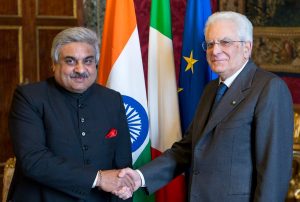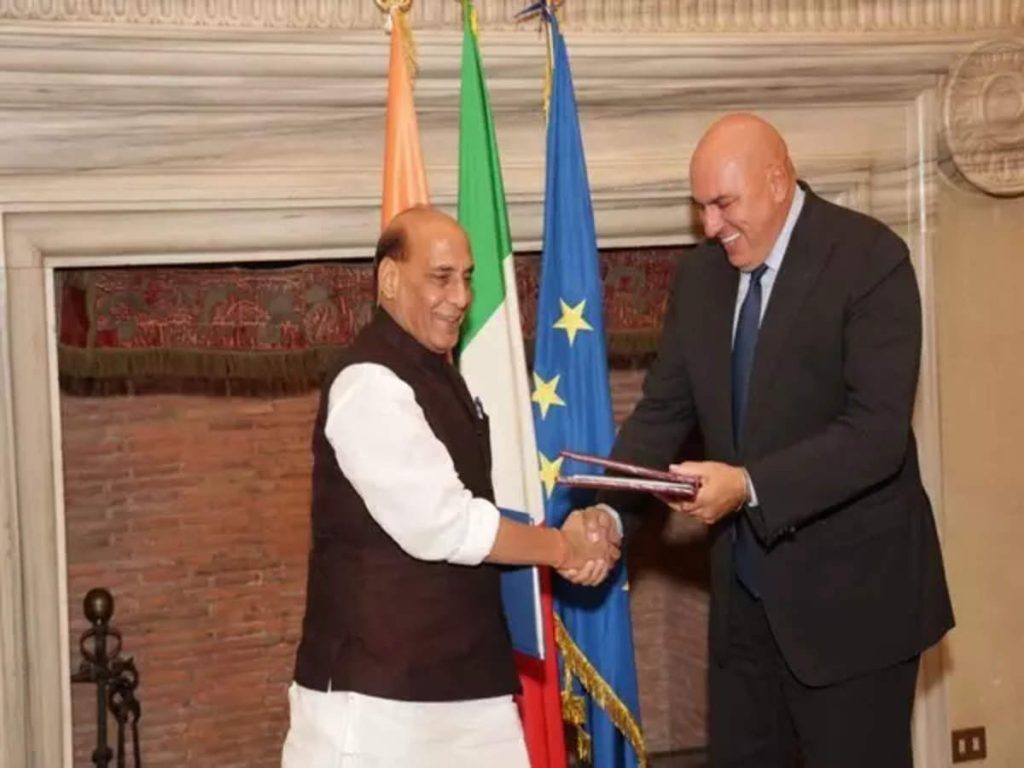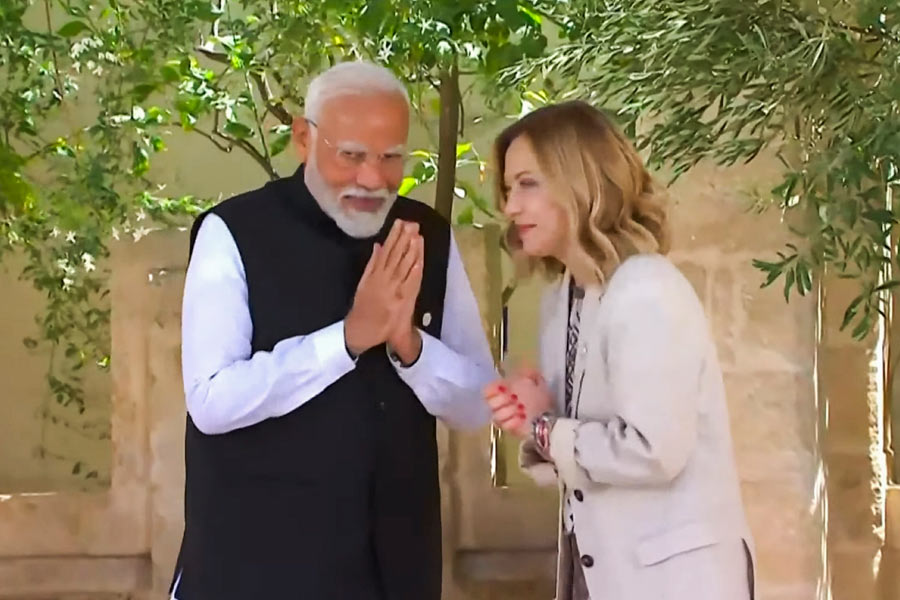PUGLIA (ITALY): This edition of “Decoding Diplomacy,” a podcast hosted by Manish Chand, CEO, Centre for Global India Insights and India Writes Network, features Ambassador Anil Wadhwa, a former ambassador of India to Italy. He discusses the evolving dynamics between India, Italy, and Europe against the backdrop of recent diplomatic engagements, including the G7 summit in Italy. From strategic partnerships to economic corridors and defence collaborations, Ambassador Wadhwa provides insights into how these relationships are shaping regional and global diplomacy. In this wide-ranging conversation, Amb. Wadhwa predicts a significant increase in India-Italy collaboration in the Indo-Pacific and Mediterranean.
Q) What is your take on the much-discussed personal chemistry between Modi and Meloni?

A) The chemistry between Prime Minister Modi and Prime Minister Meloni has always been apparent, especially in recent years. This became particularly noticeable when Prime Minister Meloni visited India in March 2023. We’ve seen this camaraderie reflected in their meetings and on television screens. This positive atmosphere aids delegation-level talks and builds confidence among interlocutors on both sides.
Since the strategic partnership was signed between the two countries in March 2023, cooperation has expanded into sensitive areas, particularly in defence. We have also seen advancements in cyber security, space cooperation, ongoing scientific and technological exchanges, and even a roadmap for future collaboration in these fields. Two very important developments have taken place. Firstly, the Mobility and Migration Partnership Agreement, which Italy signed with India, making India one of the first countries to enter such an agreement with Italy. Secondly, there is the recently signed agreement on industrial cooperation, addressing intellectual property rights and other concerns Italy had regarding manufacturing in India or the Make In India initiative, especially under Aatmanirbhar Bharat in the defence industry. These significant developments between the two sides have been greatly aided by the positive chemistry between the leaders.
Q) You mentioned enhanced defence industrial collaboration between India and Italy. Does this mean that Italy is set to become a strong partner in the Make In India initiative? What do you make of the discussions here in Puglia, Italy?

A) Defence is a crucial segment of cooperation between India and Italy. This collaboration was notably strengthened by the visit of Defence Minister Rajnath Singh to Italy in October 2023, during which an important MOU on co-production, co-development, and joint ventures in various fields was signed. Apart from this, there are existing cooperation agreements in the naval sector between the naval shipyards of both countries. These agreements provide a strong legal platform for collaboration in areas critical to the Indian defence industry, particularly under the Make In India and Aatmanirbhar Bharat initiatives.
There has been a longstanding history of cooperation between the two sides. For example, depth charges, winter clothing, and high-altitude warfare equipment have traditionally been supplied by Italian manufacturing companies to India. Producing these items in India at a much lower cost would be highly beneficial. Furthermore, this collaboration could extend to exports to third countries, enhancing the scope and impact of the partnership.
Q) In the meeting between Prime Minister Modi and Prime Minister Meloni, the two leaders also discussed enhancing cooperation and coordination in the Indo-Pacific. What is the future of India-Italy collaboration in the Indo-Pacific?
The recent actions signal a significant shift in China’s stance, particularly with the new law enacted recently. This law allows China to enforce its domestic regulations on individuals deemed to be trespassing in the South China Sea. Moving forward, we can anticipate more assertive measures by China to claim its so-called historical rights in this region. Concurrently, the presence of the United States, along with other European navies, is increasing in the South China Sea and the Pacific.
In this context, the visit of two Italian vessels to India highlights a willingness to collaborate with India in the Indo-Pacific and the South China Sea. Additionally, the emerging connectivity issues in the Mediterranean have become a crucial area of cooperation, particularly with undersea cables. This collaboration extends to digital connectivity and naval presence, potentially involving reciprocal actions by India in the Mediterranean. Consequently, we can expect a significant increase in collaboration between India and Italy in the coming years.
Q) Italy was the first European country to join the Belt and Road Initiative (BRI). However, it has now opted out, opening the door for other forms of regional connectivity, such as the India-Middle East-Europe Economic Corridor. What is the progress of Italy’s current relationship with China, and how does it interact with India’s relations with Italy? Regarding the economic corridor, what steps can India and Italy take to advance it, considering the region is plagued by crises and conflicts? What is the way forward?
A) As far as Italy’s relationship with China is concerned, it is very similar to what the European Union has adopted. This is reflected in the G7 communique, and the portion on China is very clear that Europe will protect its industry, labour, and human rights from the Chinese onslaught and what they call overcapacity, something the United States has already adopted. Europeans are willing to adopt that stance along with their allies like Japan and Canada in the G7 going forward. We will see much more of a pushback from the Europeans, and Italy is part of the G7 and, therefore, will be a leading country in that regard. We can’t expect that the relationship will be smooth sailing between Italy and China. There will be these pinpricks even as the European countries, as well as Italy, still trade with China. At the same time, they have many concerns, and these concerns are growing into a large number now. The second issue is about India’s relationship with Italy. Italy-Indian relations have thrived on their own merit, not as a rebound. Italy sees India as a valuable partner moving forward, a country with which it can do business and enter into collaborations and manufacturing. Italy views India as a democratic country with similar values, where it will be profitable to collaborate in the industrial field. The legal basis is slowly being put together to facilitate progress in this regard.
As far as the India-Middle East-Europe Economic Corridor (IMEC) IMEC is concerned, Italy was a big supporter at the recently concluded G20 Summit. We saw Saudi Arabia being roped in as well, and the UAE was a big supporter. The United States was the main guiding factor in that project, but it also had the Israeli factor at its fag end. Now, because of the conflict in Gaza, Israeli participation has gone on the back foot. However, that has not deterred a country like Italy from asking India to review where we are on this project. Italy really wants to move forward with connectivity with India and the Gulf and extend it to the Mediterranean. Italy sees itself as a country with major resources in manpower, skilled people, and excellence in exports. It brings all that to the table in this project. Going forward, Italy will become a more important country for India.
Q) China was the ghost in the room at the G7 summit in Puglia, where there was a lot of discussion on how to curb Chinese aggression, so to speak. What do you make of the current state of Europe’s relations with China? And how does this situation present an opportunity for India to elevate its relations with Europe to the next level?
A) Lately, because of the Chinese inroads into the European market, particularly in the e-mobility sector and e-vehicles, it has been seen as an onslaught against domestic industries in Europe. European countries as a whole have determined that they need to defend their industries from China’s aggressive push in this segment; otherwise, their own industries will slowly get wiped out.
And so it’s a major fear that has been creeping in for quite some time now. As we saw during this G7 summit, a decision was made to impose duties on Chinese companies making inroads into the e-vehicle category. In terms of cutting-edge technologies, there has been competition between the United States and China for quite some time. The United States is trying to rope in more and more countries and take a collective view to make similar decisions regarding China. We will see much more of a pushback from Europe going forward. All trends point in that direction. This is why we see a Chinese thrust now into Southeast Asia, Australia, and New Zealand.
Author Profile
- India Writes Network (www.indiawrites.org) is an emerging think tank and a media-publishing company focused on international affairs & the India Story. Centre for Global India Insights is the research arm of India Writes Network. To subscribe to India and the World, write to editor@indiawrites.org. A venture of TGII Media Private Limited, a leading media, publishing and consultancy company, IWN has carved a niche for balanced and exhaustive reporting and analysis of international affairs. Eminent personalities, politicians, diplomats, authors, strategy gurus and news-makers have contributed to India Writes Network, as also “India and the World,” a magazine focused on global affairs.
Latest entries
 India and the WorldNovember 26, 2025G20@20: Africa’s Moment – The Once and Future World Order
India and the WorldNovember 26, 2025G20@20: Africa’s Moment – The Once and Future World Order DiplomacyOctober 4, 2025UNGA Resolution 2758 Must Not Be Distorted, One-China Principle Brooks No Challenge
DiplomacyOctober 4, 2025UNGA Resolution 2758 Must Not Be Distorted, One-China Principle Brooks No Challenge India and the WorldJuly 26, 2025MPs, diplomats laud Operation Sindoor, call for national unity to combat Pakistan-sponsored terror
India and the WorldJuly 26, 2025MPs, diplomats laud Operation Sindoor, call for national unity to combat Pakistan-sponsored terror India and the WorldJuly 25, 2025When Fire Ends, Diplomacy Begins
India and the WorldJuly 25, 2025When Fire Ends, Diplomacy Begins








